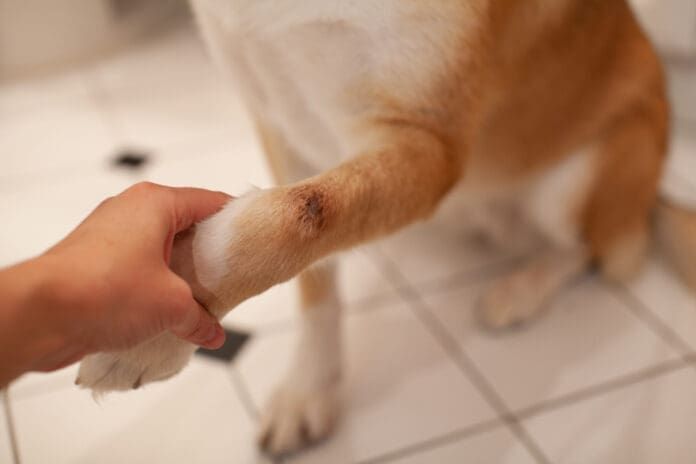While serious injuries require medical attention, many common problems can be treated on the trail or at home with simple, inexpensive, do-it-yourself remedies. To be prepared, keep natural first-aid products or their ingredients on hand to treat wounds when they occur. If a wound is bleeding, press gauze, fabric, or a paper towel against the wound. Don’t rub or scrub the wound and don’t apply hydrogen peroxide or alcohol as they can cause additional pain, discomfort, or tissue damage. Contact your veterinarian at once if the wound is deep, might require stitches, is bleeding heavily, is located near the eye or on the face, or if your dog is in severe pain or discomfort.
What Not to Do
For generations, rubbing alcohol and hydrogen peroxide have been go-to remedies for minor wounds, but neither is your best choice for treating your dog’s cuts, burns, abrasions, and similar injuries. Rubbing alcohol, a mixture of isopropyl alcohol and water, does kill germs but it actually slows rather than speeds healing. In a 2022 review of topical wound treatments, Ohio State Professor of Emergency Medicine Nicholas Kman, MD, explained that rubbing alcohol “can damage surrounding healthy tissue and shouldn’t be used to clean your wounds.” In 2007, the New York Times reviewed medical studies showing that hydrogen peroxide “has little ability to reduce bacteria in wounds and can actually inflame healthy skin cells that surround a cut or a scrape, increasing the amount of time wounds take to heal.”
First-aid Rinses
Because bacteria are everywhere, washing or rinsing the affected area can reduce the risk of infection. A simple wound-cleaning strategy is to pour a first-aid rinse over the wound from a cup, bowl, or water bottle, apply it with cotton balls, or apply it to the center of the wound with a syringe or turkey baster and add more rinse to the wound’s outer margins.
A plain water rinse removes dust, dirt, debris, and other contaminants from the wound’s surface, which reduces the risk of infection and promotes healing. Because water doesn’t contain harsh chemicals or additives, its gentle cleansing cools the wound and helps prevent irritation. The safest water to apply is sterile, meaning distilled water or tap water that has been heated to boiling and cooled. Blot moisture from around the wound and let it air dry.
A salt-water rinse has significant healing benefits, especially if you use unrefined salt, which contains minerals and trace elements. Natural markets carry several brands of unrefined sea salt, which draws moisture from bacterial cells through osmosis, which helps reduce the risk of infection. Calcium, magnesium, and other minerals promote rapid wound healing by providing essential nutrients to wounds, plus they reduce inflammation and skin irritation.
Yeas ago in my dog’s obedience class, a female German Shepherd Dog suffered from a sore that wouldn’t heal despite repeated trips to the veterinarian over several months. When her owner applied a solution of 2 tablespoons unrefined sea salt in 1/2 cup water, the sore improved that same day and healed within a week. That solution was more concentrated than most recommendations for wound rinsing, which are typically 1 teaspoon to 1 tablespoon of salt per cup of water, but nearly any salt-water solution will effectively clean wounds and speed their healing.
Herbal tea rinses made from skin-friendly herbs like chamomile, calendula, green tea, or lavender help reduce swelling, redness, and pain while inhibiting the growth of bacteria and other pathogens. To make an effective herbal rinse, place 6 teabags or 6 teaspoons (2 tablespoons) dried herbs in a 1-quart glass jar or ceramic tea pot. Fill the container with boiling water, close the lid, and let the tea stand until it cools to room temperature. Strain the tea before using. Most herbal teas stay fresh in the refrigerator for up to a week. For long-term storage, freeze herbal tea in ice cube trays, then keep the frozen cubes in labeled air-tight plastic freezer bags.
Willard Water Rinse: Willard Water, an antioxidant concentrate, can be added to water or herbal tea at the rate of 1 teaspoon per quart to help the liquid penetrate wounds and speed healing.
A vinegar rinse helps disinfect wounds while soothing the skin. Apple cider vinegar is often recommended as a wound rinse, but because it can stain white hair, use plain white distilled vinegar if your dog has a light-colored coat. In July 2022, the International Journal of Dermatology described vinegar’s proven antimicrobial, antifungal, and antioxidant properties. For dogs, dilute apple cider or white distilled vinegar with an equal amount of water before applying, or apply full-strength, then rinse after half an hour with plain water or an herbal tea.
An herbal vinegar rinse combines the skin-healing, anti-inflammatory properties of medicinal herbs with the antiseptic properties of vinegar. For an effective skin tonic, combine fresh or dried rosemary leaves, calendula blossoms, rose petals, juniper berries, lavender stalks or flowers, lemon peel, orange peel, sage, or chamomile blossoms in any combination in a glass jar, loosely filling it to about 1/3. If using fresh herbs, fill to about 1/2 of the jar. Fill the jar with raw (unpasteurized) organic apple cider vinegar. Seal the jar tightly, leave it in a warm place, and shake the jar every few days for a month. Then strain the rinse, add an equal amount of distilled or boiled and cooled water to dilute it, transfer the rinse to sterile glass jars, and store them in a cool, dark place. Note that dark herbs and apple cider vinegar will stain light or white coats.
All-purpose Soothing Wound Treatment
WDJ contributor Mary Straus creates her own canine wound cleanser by combining 1 part aloe vera juice or gel with 3 parts witch hazel. In a 2-ounce bottle, this would be 1 tablespoon aloe vera and 3 tablespoons witch hazel, to which she adds 2 drops of lavender essential oil. “I shake it up before using,” she says. “I’ve found that it soothes any itch and helps keep a dog’s mouth off any wound or abrasion.” She applies the blend with cotton balls and lets the mixture air dry. None of the wounds she has treated for the past 30 years has become infected.
Witch hazel is rich in tannins, which are naturally occurring compounds found in plants, seeds, bark, and leaves and which have antimicrobial and anti-inflammatory properties. Look for witch hazel products with no added fragrance and which contain little or no alcohol, such as Thayers or Dickinson’s.
Apply an After-Rinse Treatment
While this step isn’t necessary if the wound is minor, it helps to be prepared if additional treatments, such as the following, are needed.
Honey
Manuka or any high-quality raw (unpasteurized) honey can be applied as an ointment for burns, cuts, and other wounds. Clinical trials of human patients show that the application of honey as a wound dressing rapidly clears infection, inflammation, swelling, pain, and odor while speeding the sloughing off of necrotic (dead skin) tissue and the growth of new skin cells. Honey remains moist, seals and protects wounds, absorbs pus, reduces scarring, and prevents wounds from sticking to bandages. Unlike most topical antiseptics, honey prevents microbial growth without causing tissue damage.
Manuka honey from Australia is well known because of its scientific testing, but all raw organic honeys have medicinal benefits. In 2021, the journal Open Life Sciences published an updated review of honey as a wound healer and found that it significantly improved the healing of burns, abrasions, scratches, and infected wounds.
To use, rinse a burn or other wound, then apply a thick layer of honey. For burns, apply every 10 minutes until the pain subsides, and follow with a light bandage. It may be necessary to clip hair from the treated area and use a cervical or Elizabethan collar to prevent the dog from licking the honey.
Over time, raw honey can crystalize, forming sharp points and solidifying so it’s impossible to pour. To return honey to its original state, place it in a bowl that you warm in hot water or gently heat the honey at low temperature on the stove (don’t use a microwave), then cool before applying.
Coconut Oil
Coconut oil’s medium-chain fatty acids fight harmful bacteria, viruses, yeasts, fungi, and parasites, making it an effective salve or dressing for cuts and wounds of every description. Its only downsides are that most dogs love the taste and want to lick it off, and at temperatures below 75o F, it’s solid. If the wound is where your dog can’t reach, keeping it moist with a small amount of coconut oil can be an excellent idea. To soften coconut oil that has turned hard, keep some in a small jar or bottle for easy warming.
Aromatherapy
Many essential oils have antibacterial or disinfecting properties. For safety when treating dogs, essential oils should be diluted with a carrier oil or other liquid base. According to Colorado aromatherapist Frances Fitzgerald Cleveland, the best carrier for canine cuts, burns, abrasions, and other wounds is organic cosmetic-grade aloe vera gel, which is both soothing and healing.
Here is a blend you can create without having to invest in the expensive essential oils Cleveland uses in her FrogWorks pet aromatherapy products. “Use a clean glass jar with a nice lid,” she recommends, “and combine 30 ml (2 tablespoons or 1 fluid ounce) organic cosmetic-grade aloe vera gel with 20 drops lavender (Lavandula angustifolia) essential oil. Stir to mix thoroughly, then dab a tiny amount onto the wound.” This recipe is simple, safe, affordable, effective, and uncomplicated, making it ideal for dog lovers to try.
Liquid Bandages
Pet supply stores and veterinary clinics carry “liquid bandage” products that protect wounds, keep them moist, and speed healing. Examples include Miracle Care Pet Liquid Bandage Spray, DogsWell Liquid Bandage, Well & Good Dog Liquid Bandage Spray, and Vet Worthy Liquid Bandage for Dogs.
BleedClot for Pets
Styptic powder is a familiar grooming product that stops the bleeding of nails that are too closely trimmed. The veterinary product BleedClot, from the makers of the human product BleedStop, is an easy-to-apply powder that goes beyond styptic powder by stopping the bleeding of small, large, shallow, and deep wounds on contact. Nonstinging, sterile, and hypoallergenic, BleedClot does not stain tissue and is safe for animals even if ingested. Its main ingredient, amylopectin, acts as a dehydrating “sponge” when applied, soaking up water and blood plasma. This product is recommended for any bleeding wound.
Do You Need a Bandage?
A bandage’s main advantage is that it helps keep a wound clean and protected from contamination. However, bandaging a dog’s wound may not be necessary. If in doubt, consult your veterinarian, who can advise you on bandaging techniques.







I was interested in reading this article as my dog had just recently scraped the top of his head somehow, a minor wound – yet I was interested in knowing ways to treat it. The article includes a clickable link to a product, called EMT gel, which supposedly can keep the area moist and form a bit of a barrier or seal. Unfortunately I cannot find any place that carries this product, and the manufacturer’s website, which links a distributor, was not helpful as that company no longer carries it either. If anyone can locate this product, I’d like to get it. Or perhaps a recommendation for a comparable product with the same ingredients/contents.
Some of this article is alt-med weirdness, and some of it is misleading. You advise against hydrogen peroxide because it might cause pain, but then recommend salt and vinegar, which could cause more pain. Both salt and vinegar need to be diluted properly.
The instruction to “dilute apple cider or white distilled vinegar with an equal amount of water before applying, or apply full-strength” is misguided. Full-strength vinegar can burn an open wound. For a vinegar solution, a tablespoon of vinegar should be mixed with a cup of boiled water. (Using tap water risks infections.) For salt, doctors recommend a half teaspoon of salt in a cup of boiled water. A teaspoon would be OK, but your solution, “2 tablespoons unrefined sea salt in 1/2 cup water,” is too strong. I think it worked in that anecdote because the dog’s wound was already a few months old.
In response to SUSIE Picart’s comment, I was also unsuccessful in finding any retailer with EMT Gel available. I searched for a product with the same ingredients and found a medical company, Sanara Med Tech, that uses the same ingredient: type 1 hydrolyzed collagen. Sanara’s registered trademark is HYCOL Gel whereas EMT’s is Collascent. Sanara markets products to physicians, hospitals, clinics, and post-acute care settings, so perhaps it could be available through a veterinary practice. I’ll ask about it when I see my vet at the end of the month.
EMT gel was my go to product and worked like magic. Unfortunately and inexplicably the company told me they discontinued the product. We need some company to buy the exact formula and start making it again!
test comment